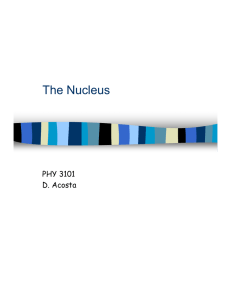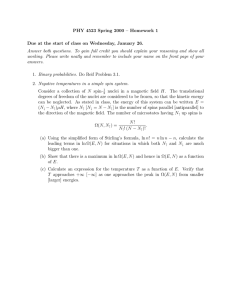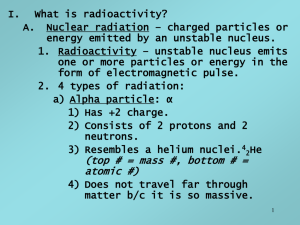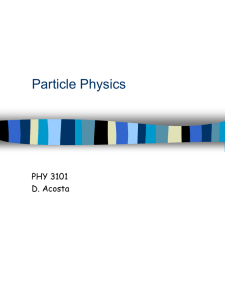Nuclear Spin and Stability PHY 3101 D. Acosta
advertisement
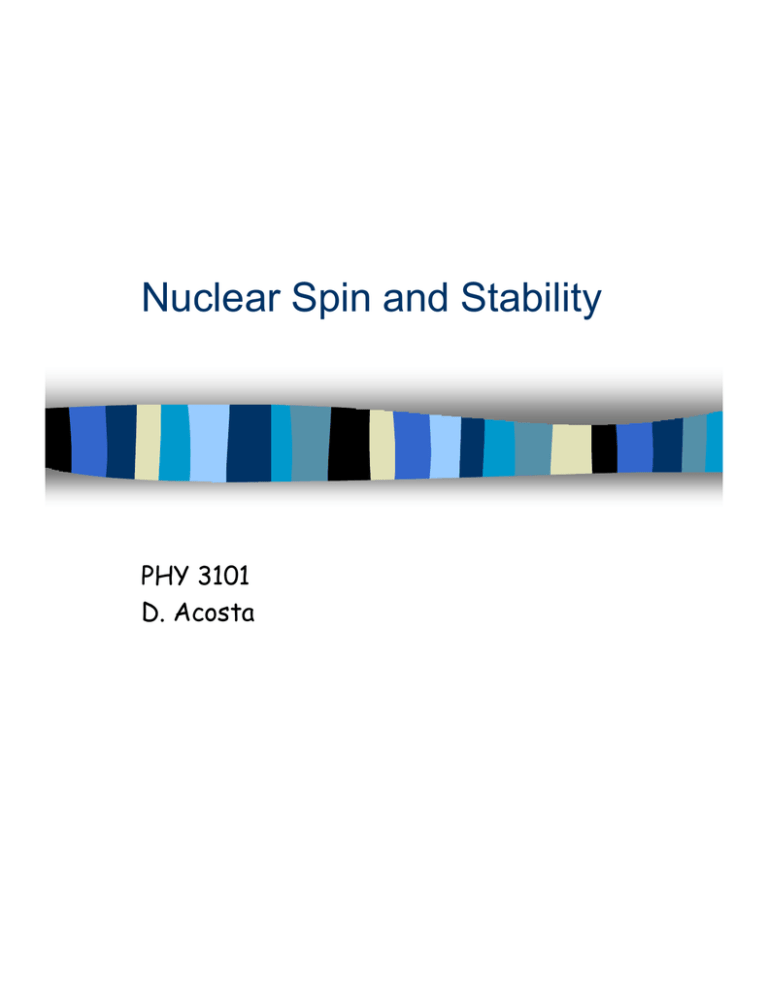
Nuclear Spin and Stability PHY 3101 D. Acosta Nuclear Spin n n n neutrons and protons have s = ½ (ms = ± ½) so they are fermions and obey the PauliExclusion Principle The nuclear magneton is eh m eh 1 µN = = e = µB 2mp mp 2me 1840 The proton magnetic moment would be µ p = gs µ N ms = 2 µ N n n 1 = µN 2 But actually, µ p = 2.79 µ N ≠ µ B like the electron µ n = −1.91µ N ≠0 even with q = 0 Thus, the neutron and proton have complicated charge distributions – They are not fundamental particles… 12/4/2000 PHY 3101 -- D. Acosta 2 Zeeman Effect n In the atom, the orbital angular momentum of the electrons gives rise to a magnetic dipole moment which interacts with external magnetic fields V = − µ ⋅ B = − µ B B ml n In the normal Zeeman effect, atomic states with angular momentum have split energy levels in the presence of a magnetic field: ∆E = µ B B ∆ ml n n Similarly, a single particle with intrinsic angular momentum (spin) can interact with an external magnetic field, with different energy configurations There can be transitions between these different energy levels. A photon is emitted or absorbed in the process ∆E = Eγ = hf = µ B B 12/4/2000 PHY 3101 -- D. Acosta 3 Nuclear Magnetic Resonance n Now consider an H-atom nucleus (proton) in a 1 T magnetic field. Since the nuclear magnetic moment is smaller than the Bohr magneton, the transition energy is smaller ∆E = gs µ p B∆ms µB 5.79 × 10 −5 eV ∆E = 2 × 2.79 µ N B = 2 × 2.79 B = 2 × 2.79 1840 1840 ∆E = 1.76 × 10 −7 eV n The frequency of emission/absorption is f= n n n ∆E = 42 MHz h (radio spectrum) A sample of protons (like the human body) will resonate at this frequency. – Radio waves at this frequency induce transitions – Strong absorption of radio waves if there is a population difference between the two energy states (thermal distribution) Studied by I.I.Rabi in 1938 (Nobel in 1944) Now applied to medical imaging: – Magnetic Resonance Imaging (MRI) 12/4/2000 PHY 3101 -- D. Acosta 4 Nuclear Shell Model n Recall the electron configuration of atoms: Kr: 1s 2 2s2 2 p6 3s2 3 p6 4 s2 3d 10 4 p6 n n n n n n Closed subshells occur after the following number of electrons: Z = 2, 10, 18, 36, 54, 80, 86 Refer to these as atomic magic numbers Configuration is very stable – Large ionization energy ⇒ inert gases Similar behavior is seen in the binding energy of nuclei – Plot of B.E./A Since neutrons and protons are fermions, the Pauli-Exclusion Principle applies Nuclei also have shell structure 12/4/2000 PHY 3101 -- D. Acosta 5 Nuclear Structure n n The Pauli-Exclusion Principle applies to neutrons and protons separately – Not together because n, p are distinguishable from each other Ground state configurations 4 2 He p n s=0 3 2 He p n s = 1/ 2 E EF n=3 n=2 n=1 12 6C n n p n Tend to want to have equal numbers of neutrons and protons to minimize the total energy of the nucleus Too many n’s or p’s causes binding energy to be negative -- unstable 12/4/2000 PHY 3101 -- D. Acosta 6 Nuclear Magic Numbers n Carbon-14 is unstable (radioactive) n=4 E n=3 n=2 n=1 14 6C n n n n p n 2 2 Some nuclei never form: 0 n, 2 He Certain configurations are very stable – Z or N = 2, 8, 20, 28, 50, 82, 126 These are the Nuclear Magic Numbers – Apply separately to neutrons and protons – These nuclei have large binding energies – Correspond to closed nuclear subshells “Doubly Magic” nuclei are extremely stable: 4 2 He ≡ α - particle has Z = 8, N = 8 16 8O 208 82 Pb 12/4/2000 has Z = 2, N = 2 (lead) has Z = 82, N = 126 PHY 3101 -- D. Acosta 7 Stability n n n A nucleus is stable if the mass of the decay products is greater than the mass of the nucleus A nucleus is unstable if the mass of the decay products are less than the mass of the nucleus Consider the α-particle: includes d Hei = 4.002602 u electrons M d ni = 1.008665 u M d Hi = 1.007825 u 2 × M d n+ Hi = 4.033 u > M d He i M 4 2 1 0 1 1 1 0 1 1 4 2 B = 0.0293 u × 931.5 MeV / u = 28.3 MeV B / A = 7.07 MeV n (binding energy per nucleon) If a nucleus is unstable, it is only a matter of time before it decays into a different nucleus 12/4/2000 PHY 3101 -- D. Acosta 8 Radioactivity n Radioactive Decay Law dN = −λ N dt N = number of nuclei at time t λ = decay constant dN = − λN dt ⇒ N ( t ) = N 0 e − λt n Mean lifetime ≡ τ = 1/λ n Half-life ≡ t1/2 = ln 2 / λ = 0.693 τ N/N0 0.5 e-1 t1/2 τ 12/4/2000 PHY 3101 -- D. Acosta 9 Activity Activity ≡ R = − n n n n dN = λN (t ) dt Decreases exponentially Units: disintegrations per second ≡ Bequerel (Bq) – Bequerel discovered radioactivity in uranium in 1896 Older unit: Curie (Ci) = 3.7×1010 Bq – Decay rate in 1g of radium Various decay modes possible: – α, γ, β-, β+, as well as electron-capture 12/4/2000 PHY 3101 -- D. Acosta 10 Beta Decay n e− Examples: n → p + β− +νe 14 14 − 6 C→ 7 N + β + νe A A − X → X + β Z Z +1 n + νe in general Why the neutrino? – In the rest frame of the nucleus, the decay products would otherwise have a fixed energy of ½ × binding energy – This not observed: EK n EK= B/2 Either momentum is not conserved, or else there is an invisible third particle 12/4/2000 PHY 3101 -- D. Acosta 11 The Neutrino n n n n n n n n Pauli proposes such an invisible particle in 1930 in a letter to a conference Enrico Fermi develops this in a theory, and calls it the neutrino – little neutral one The neutrino has spin ½, no charge, and nearly zero mass It does not interact via the electromagnetic force or the strong nuclear force, only the weak nuclear force The weak force is the only force which changes one particle into another Because of such a weak interaction, a neutrino can penetrate 10 light-years of steel ! Must produce huge numbers of neutrinos to observe one: – Nuclear explosion – Nuclear reactor Cowen & Reines observe the neutrino in 1956 at a reactor (Nobel prize: 1995) 12/4/2000 PHY 3101 -- D. Acosta 12

